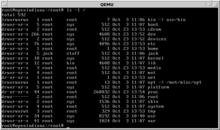38:
473:
161:, this can be changed to point to a super-root directory, where remote trees can be mounted. If, for example, two workstations "pcs2a" and "pcs2b" were connected via "connectnodes" and "uunite" startup script, "/../pcs2b" could be used to access the root directory of "pcs2b" from "pcs2a".
132:. This is typically done to create a secluded environment to run software that requires legacy libraries and sometimes to simplify software installation and debugging. Chroot is not meant to be used for enhanced security as the processes inside can break out.
123:
has its own idea of what the root directory is. For most processes this is the same as the system's actual root directory, but it can be changed by calling the
356:
107:, the directory entry itself has no name – its path is the "empty" part before the initial directory separator character (
99:
Unix abstracts the nature of this tree hierarchy entirely and in Unix and Unix-like systems the root directory is denoted by the
272:
301:
424:
494:
17:
330:
230:
451:
146:
Some Unix systems support a directory below the root directory. Normally, "/.." points back to the same
87:
on which the root directory is located; it is the filesystem on top of which all other file systems are
84:
387:
76:
72:
31:
141:
8:
120:
111:). All file system entries, including mounted file systems are "branches" of this root.
379:
478:
420:
241:
178:
88:
383:
371:
236:
64:
264:
181:, each partition has a drive letter assignment (e.g. the C partition is labeled
416:
210:
202:
37:
488:
352:
293:
375:
129:
103:(slash) sign. Though the root directory is conventionally referred to as
53:
42:
206:
61:
50:
322:
156:
472:
443:
79:, as the starting point where all branches originate from. The
125:
294:"Root Filesystem Definition by The Linux Information Project"
151:
147:
194:
174:
57:
350:
214:
170:
75:
in a hierarchy. It can be likened to the trunk of a
468:
486:
185:) and there is no public root directory on it.
450:. The Linux Information Project. 2007-10-27.
404:
351:Brownbridge, David R.; Marshall, Lindsay F.;
344:
438:
436:
27:First or top-most directory in a hierarchy
433:
410:
217:systems this superuser home directory is
83:is the file system contained on the same
36:
201:(pronounced "slash root"). This is the
14:
487:
164:
119:In UNIX-like operating systems, each
259:
257:
94:
24:
197:, there is also a directory named
41:View of the root directory in the
25:
506:
364:Software: Practice and Experience
254:
471:
454:from the original on 2021-05-08
333:from the original on 2020-11-12
304:from the original on 2021-07-10
275:from the original on 2020-10-26
188:
315:
286:
13:
1:
323:"What chroot() is really for"
247:
231:Filesystem Hierarchy Standard
135:
56:, and primarily used in the
7:
265:"Root Directory Definition"
224:
10:
511:
357:"The Newcastle Connection"
139:
29:
411:Callaghan, Brent (2000).
114:
71:is the first or top-most
91:as the system boots up.
495:File system directories
150:as "/", however, under
376:10.1002/spe.4380121206
46:
40:
32:Root (disambiguation)
142:Newcastle Connection
30:For other uses, see
165:DOS/Windows systems
47:
479:Technology portal
444:"Root Definition"
242:Working directory
179:Microsoft Windows
95:Unix-like systems
65:operating systems
16:(Redirected from
502:
481:
476:
475:
463:
462:
460:
459:
440:
431:
430:
408:
402:
401:
399:
398:
392:
386:. Archived from
361:
348:
342:
341:
339:
338:
319:
313:
312:
310:
309:
290:
284:
283:
281:
280:
261:
237:Parent directory
220:
200:
184:
160:
128:
110:
106:
102:
81:root file system
45:operating system
21:
18:Root file system
510:
509:
505:
504:
503:
501:
500:
499:
485:
484:
477:
470:
467:
466:
457:
455:
442:
441:
434:
427:
413:NFS Illustrated
409:
405:
396:
394:
390:
359:
349:
345:
336:
334:
321:
320:
316:
307:
305:
292:
291:
287:
278:
276:
263:
262:
255:
250:
227:
218:
198:
191:
182:
167:
154:
144:
138:
124:
117:
108:
104:
100:
97:
35:
28:
23:
22:
15:
12:
11:
5:
508:
498:
497:
483:
482:
465:
464:
432:
425:
417:Addison Wesley
403:
353:Randell, Brian
343:
314:
285:
252:
251:
249:
246:
245:
244:
239:
234:
226:
223:
205:of the 'root'
203:home directory
190:
187:
166:
163:
137:
134:
116:
113:
96:
93:
85:disk partition
69:root directory
26:
9:
6:
4:
3:
2:
507:
496:
493:
492:
490:
480:
474:
469:
453:
449:
445:
439:
437:
428:
426:0-201-32570-5
422:
418:
414:
407:
393:on 2016-08-16
389:
385:
381:
377:
373:
370:: 1147–1162.
369:
365:
358:
354:
347:
332:
328:
324:
318:
303:
299:
295:
289:
274:
270:
269:techterms.com
266:
260:
258:
253:
243:
240:
238:
235:
232:
229:
228:
222:
216:
212:
208:
204:
196:
186:
180:
176:
172:
162:
158:
153:
149:
143:
133:
131:
127:
122:
112:
92:
90:
86:
82:
78:
74:
70:
66:
63:
59:
55:
52:
44:
39:
33:
19:
456:. Retrieved
447:
412:
406:
395:. Retrieved
388:the original
367:
363:
346:
335:. Retrieved
326:
317:
306:. Retrieved
297:
288:
277:. Retrieved
268:
192:
189:Related uses
168:
145:
118:
98:
80:
68:
48:
209:. On many
155: [
130:system call
54:file system
43:OpenIndiana
458:2021-11-03
397:2016-08-16
337:2014-02-12
308:2020-03-14
279:2020-03-14
248:References
140:See also:
136:Super-root
448:LInfo.org
298:LInfo.org
219:/var/root
207:superuser
73:directory
62:Unix-like
489:Category
452:Archived
355:(1982).
331:Archived
302:Archived
273:Archived
225:See also
193:On many
51:computer
384:1840438
327:LWN.net
121:process
89:mounted
423:
382:
195:Unixes
177:, and
169:Under
126:chroot
115:chroot
67:, the
391:(PDF)
380:S2CID
360:(PDF)
233:(FHS)
199:/root
159:]
152:MUNIX
148:inode
49:In a
421:ISBN
213:and
175:OS/2
77:tree
60:and
58:Unix
372:doi
215:iOS
211:Mac
183:C:\
171:DOS
491::
446:.
435:^
419:.
415:.
378:.
368:12
366:.
362:.
329:.
325:.
300:.
296:.
271:.
267:.
256:^
221:.
173:,
157:de
461:.
429:.
400:.
374::
340:.
311:.
282:.
109:/
105:/
101:/
34:.
20:)
Text is available under the Creative Commons Attribution-ShareAlike License. Additional terms may apply.
